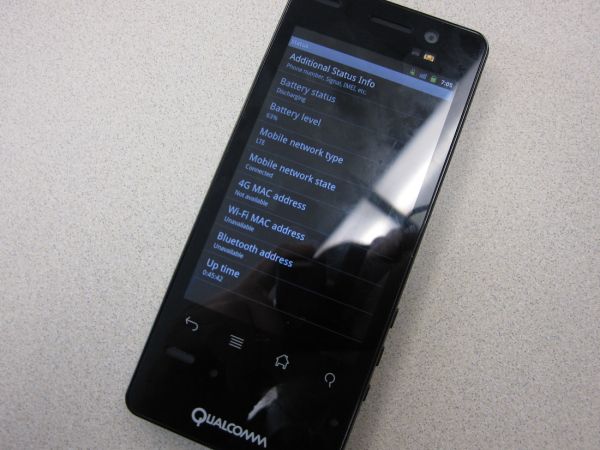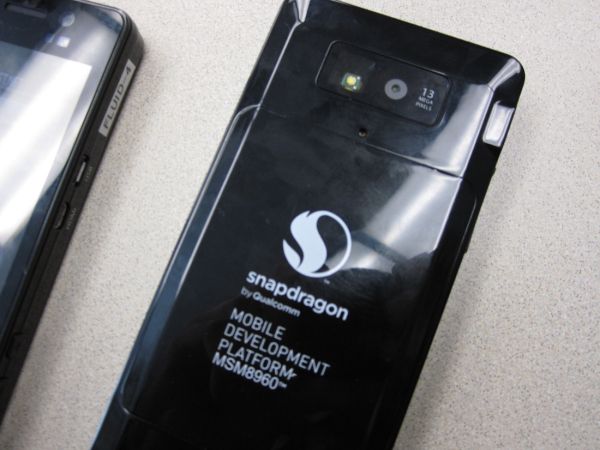Qualcomm's New Snapdragon S4: MSM8960 & Krait Architecture Explored
by Brian Klug & Anand Lal Shimpi on October 7, 2011 12:35 PM EST- Posted in
- Smartphones
- Snapdragon
- Arm
- Qualcomm
- Krait
- MDP
- Mobile
- SoCs
MSM8960 Cellular Connectivity
Until now, to get 4G LTE connectivity in a smartphone has required using two basebands - one for delivering 4G LTE connectivity, and a more traditional smartphone-geared baseband for voice on 2G and 3G data. Take Verizon’s 4G LTE smartphone lineup for example, where many devices combine MSM8655 for camping a 1x voice session alongside MDM9600 for EVDO and LTE, or some other similar combination. Further, all those LTE basebands are built on 45nm process and really geared towards data specific applications.
For a while now we’ve also been talking about 28nm LTE basebands, and specifically the multimode connectivity on MSM8960. This is the first of Qualcomm’s S4 SoCs, and includes 4G LTE connectivity alongside the usual assortment of WCDMA/GSM/CDMA2000 standards. MSM8960’s cellular baseband is based around Qualcomm’s second generation (3GPP Rel.9) LTE modem, which is exactly what’s inside MDM9x15 which we’ve talked about in the past.
The full laundry list of what air interfaces MDM8960 supports is impressive - LTE FDD/TDD, UMTS, CDMA, TD-SCDMA (for Chinese markets), and GERAN (GSM/EDGE). I’ve made a small table below which gives the full laundry list.
| Snapdragon S4 - MSM8960 Cellular Support | |
| LTE FDD | 100 Mbps DL / 50 Mbps UL (Cat. 3, 3GPP Rel.9) |
| LTE TDD | 68 Mbps DL / 17 Mbps UL (Cat. 3, 3GPP Rel.9) |
| UMTS | DC-HSPA+ 42 Mbps DL (Cat. 24) / 11 Mbps UL (Cat. 8) |
| CDMA2000 | 1xAdvanced, EVDO Rev.B (14.7 Mbps DL / 5.4 Mbps UL) |
| GSM | GSM/GPRS/EDGE |
| TD-SCDMA | TD-SCDMA 4.2 Mbps DL / 2.2 Mbps UL |
What’s new again is inclusion of a category 3, 4G LTE baseband into the SoC alongside DC-HSPA+ and TD-SCDMA for the Chinese market. This is a substantial increase in the number of air interfaces supported onboard the SoC which will enable tighter integration and lower power from the baseband being manufactured on that same 28nm process. There’s still the requirement for external RF and transceiver (using RTR8600 or something similar) which houses all the analog, but that’s the same everywhere else.
Since the baseband in MSM8960 is shared with MDM9x15, the two are both 3GPP Release 9 devices, whereas presently MDM9600 and other launch LTE devices are 3GPP Release 8, which was the launch standard. This newer 3GPP release brings a number of improvements, and closer to transitioning to Voice over LTE (VoLTE) and SRVCC (single radio voice call continuity) for fallback to GSM/UMTS or 1x voice in the circumstance that 4G LTE coverage fades. The present combination of a camped 1x voice session alongside 4G LTE for data is also possible in MDM8960, which is exactly what’s done in the case of the HTC Thunderbolt.
In time, carriers will transition to using VoLTE and enrich the voice experience by offering services that work across the data session, alongside some circuit switched (CS) traditional 2G/3G voice to fall back to. For CDMA networks that’ll continue being the dual RF scenario which uses 1x for voice, and for UMTS networks that’ll be a SRVCC augmented fast handover to 3G for voice calls. This handover and call setup is targeted to take place in under one second.
There’s more to the connectivity situation as well, as MSM8960 includes built in WLAN 802.11b/g/n (single spatial stream), Bluetooth, and GPS. These are integrated directly into the MSM8960 the same way the cellular modem is and only require some external RF to use.
Of course, it’s one thing to talk about all this connectivity on MSM8960 and something else entirely to see it. With MSM8660, Qualcomm gave us one of their Mobile Development Platforms (MDPs) which is something of a reference design and development board for each SoC generation.
This time was no exception, and they showed off their new MSM8960 MDP connected to Verizon’s 4G LTE network streaming 1080p YouTube video, loading pages, and finally running a few speedtests using the Speedtest.net application.
This was all over Verizon’s 4G LTE network at Qualcomm HQ in San Diego and worked impressively well for hardware and software that still isn’t production level. In spite of marginal signal in the room we performed testing in, the MDP finished tests with pretty decent results. I ran some more tests on a Droid Bionic in the same room and saw similar results.
Final Words
Qualcomm has had MSM8960 silicon back in house for the past 3 months and is on-track for a release sometime in the first half of next year. Assuming Qualcomm can deliver on its claims, performance alone would be enough to sell this chip. Improved power characteristics and integrated LTE baseband really complete the package though.
The implications for a 1H 2012 MSM8960 release are tremendous. Android users will have to choose between a newer software platform (OMAP 4 running Ice Cream Sandwich) or much faster hardware (MSM8960). Windows Phone users may finally get a much needed performance boost if Microsoft chooses to standardize on Krait for its Windows Phone hardware refresh next year. End users will benefit as next year's smartphones and tablets will see, once again, a generational performance improvement over what's shipping today. LTE should also start to see much more widespread adoption (at the high end) as a result of Qualcomm's integrated LTE baseband.












108 Comments
View All Comments
introiboad - Friday, October 7, 2011 - link
Really? I wasn't aware of anyone else in the industry not using ARM's RTL and designing their cores from scratch.z0mb13n3d - Friday, October 7, 2011 - link
Well then, perhaps you haven't heard of Marvell and their Armada line of SoC's?introiboad - Friday, October 7, 2011 - link
Yes, I have heard of Marvell and Armada, isn't that what's left of XScale? Honestly I thought they had given up on what was XScale and licensed the RTL like everyone else instead, but it looks like I was wrong.metafor - Friday, October 7, 2011 - link
Which is probably why Anand specified tablet/smartphones. Marvell is, for all practical purposes, not a major or even relevant player in tablet/smartphones.It is worthy to note that both nVidia and (thus believed) Apple are utilizing their architectural licenses and are cooking up their own cores currently. But none will likely launch in 2012.
Anand Lal Shimpi - Friday, October 7, 2011 - link
The qualification there was "in the smartphone/tablet space". Marvell hasn't had any significant design wins in the high end Android, iOS, Windows Phone or QNX OS space that we cover.Is there another company you are referring to?
Take care,
Anand
Mike1111 - Friday, October 7, 2011 - link
What about the ST-Ericsson Nova A9600?http://www.stericsson.com/press_releases/NovaThor....
It's a 28nm dual-core Cortex-A15 (up to 2.5 GHz) with an Imagination Rogue GPU (Series 6, 210 GFLOPS). Taped out and set to ship in 2012:
http://www.eetimes.com/electronics-news/4226942/ST...
And I'm sure we will see an Apple A6 in the next 12 months (IMHO could be quite similar to the Nova A9600 in terms of CPU and GPU).
Anand Lal Shimpi - Friday, October 7, 2011 - link
Neither of those options are custom designs using the ARM ISA, they are full IP licenses.You are correct on ST-E's announcement though, I simply haven't been factoring them into discussions lately as they have been pretty much not present in the high-end smartphone space as of late.
Take care,
Anand
partylikeits1999 - Saturday, October 8, 2011 - link
I'm hearing that this one has slipped, and now the ST-Ericsson chipset with Rogue won't sample to OEMs until the first half of next year and therefore won't be in commercial products until the very end of 2012 if at all, whereas the MSM8960 is already sampling to OEMs according to Qualcomm. In other words, schedule-wise, you're probably comparing apples to oranges. I do agree with you though that we'll likely see A6 from Apple, in some form, by this time next year, but I think it'll be higher spec'd and will blow the doors off anything from STE. The more interesting question is whether the quad core 8064 that Qualcomm has mentioned for next year, can keep up with A6, both from a CPU and a GPU standpoint.ArunDemeure - Friday, October 7, 2011 - link
Marvell indeed hasn't had much luck in the high-end so far, but the same latest PJ4 core has been fairly successful both as the HSPA Pantheon 920 at BlackBerry (including some new BlackBerry 7 devices) and the TD-SCDMA Pantheon 910 for various China Mobile-specific phones. So I'm not sure it's a good idea to exclude them completely although they're certainly not in the same league as Qualcomm so I really don't blame you.macs - Friday, October 7, 2011 - link
Are you really sure that the upcoming Nexus Prime will use OMAP 4?Seems unlikely to me... A SGX 540 to power a 720p display when Samsung as their own better SOC with Mali 400?? And the rival iPhone 4S use a GPU that is 7/8 times faster than SGX540.
Sounds really stupid... I can't believe that OMAP 4 is the reference SOC for Android ICS